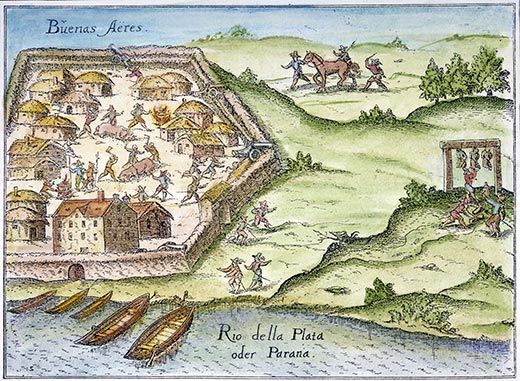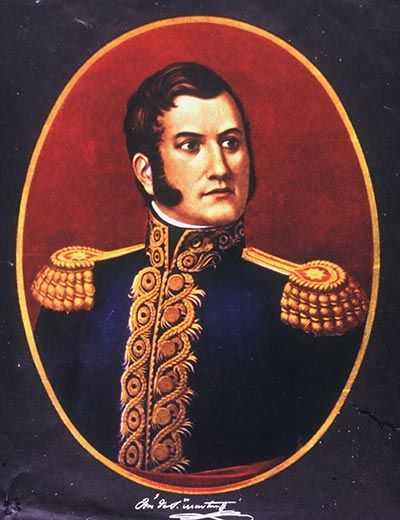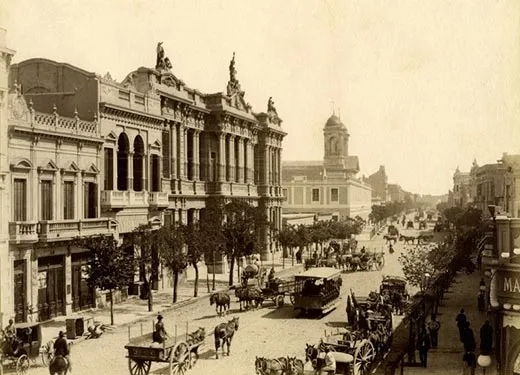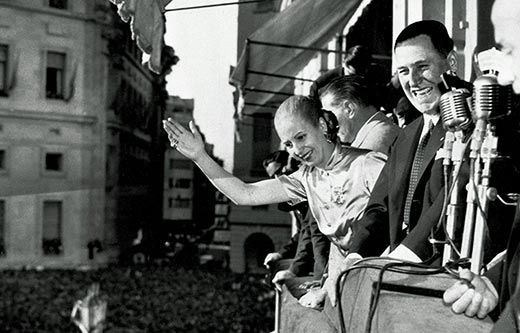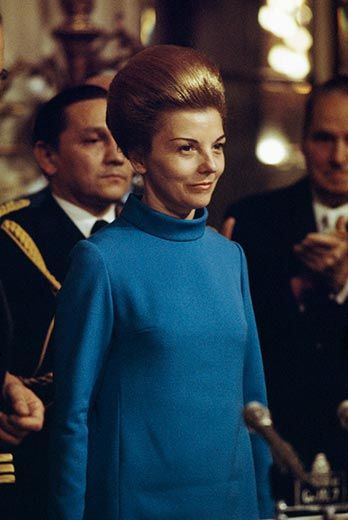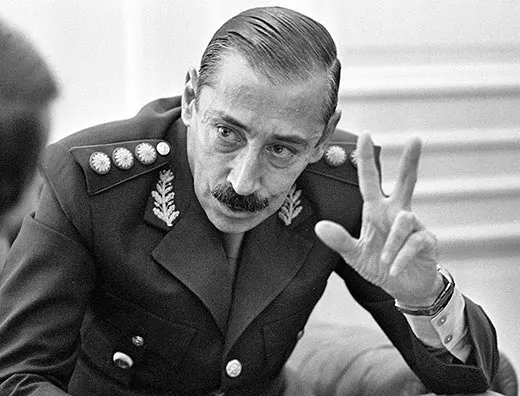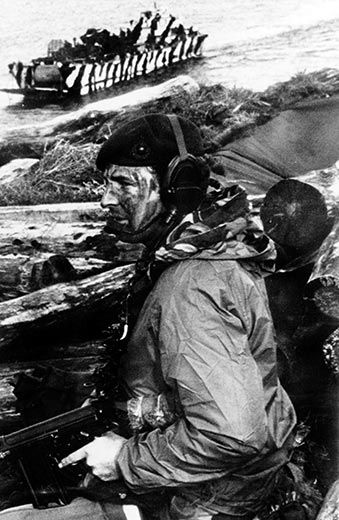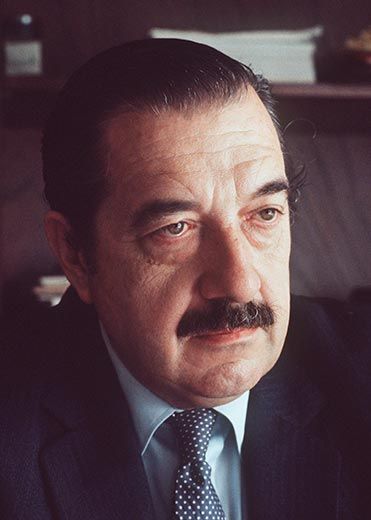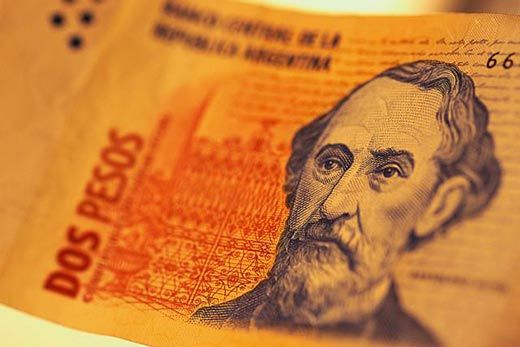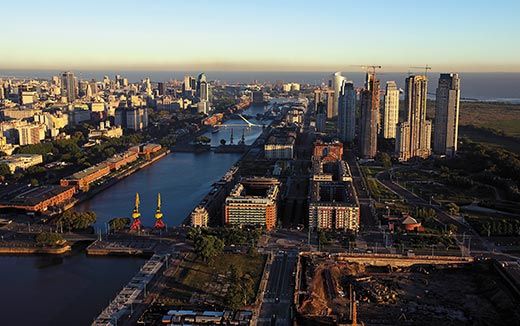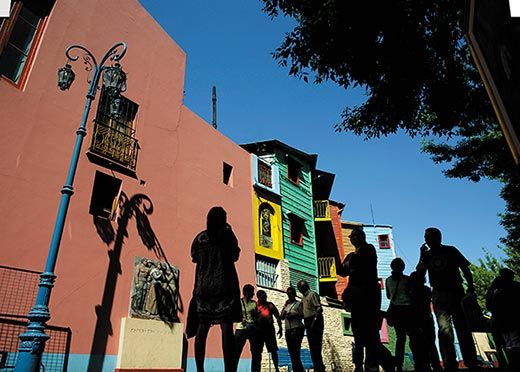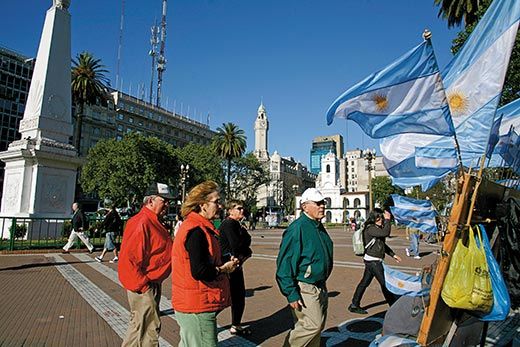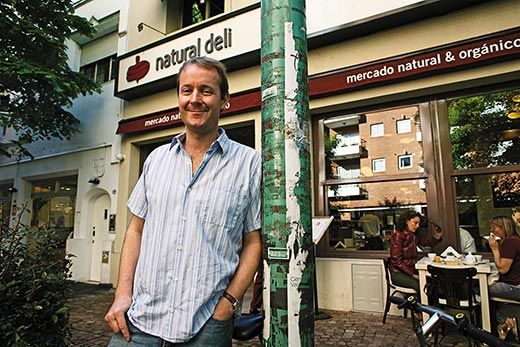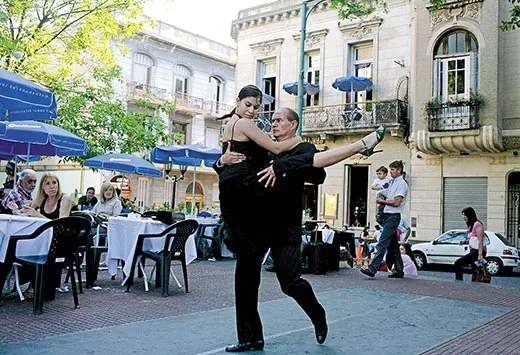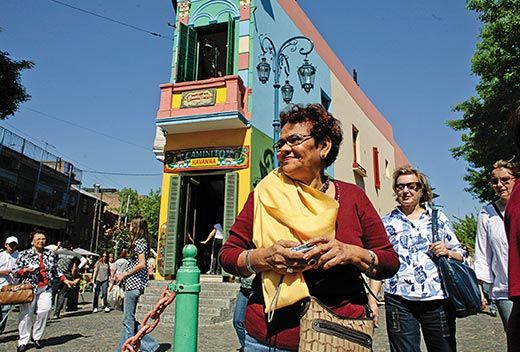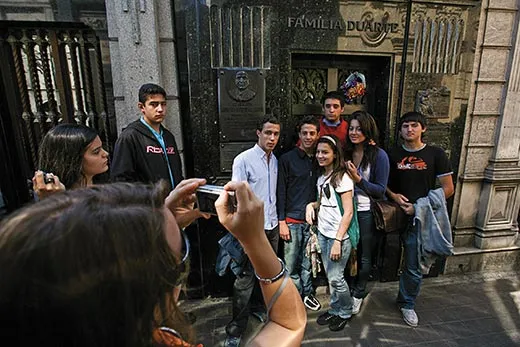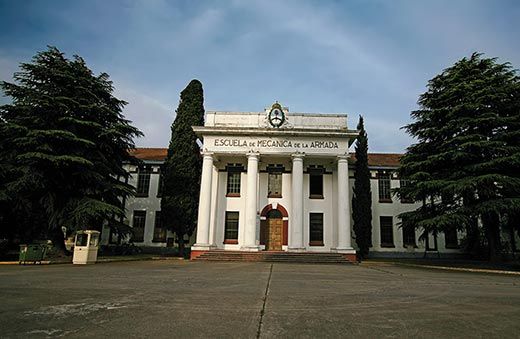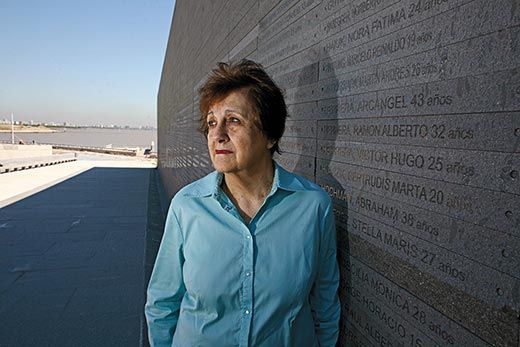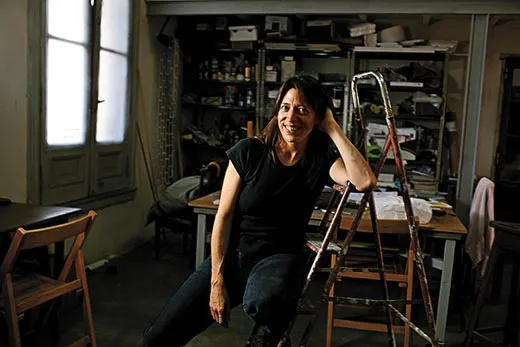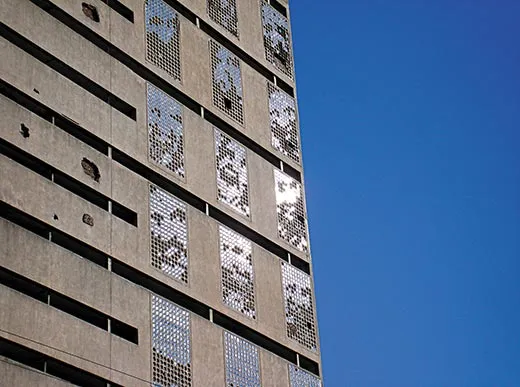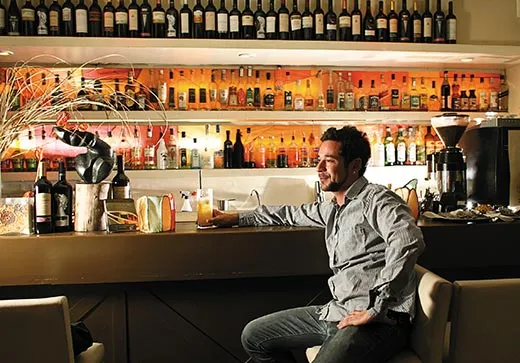Buenos Aires: a City’s Power and Promise
The stylish and affordable capital of Argentina has become a big hit with growing numbers of foreigners
/https://tf-cmsv2-smithsonianmag-media.s3.amazonaws.com/filer/Buenos-Aires-Argentina-Boca-neighborhood-631.jpg)
"When I moved here, you had to learn how to speak Spanish," says Wendy Gosselin, a translator from Brighton, Michigan, who runs her own business and relocated to Buenos Aires a decade ago. "Now you go into a restaurant and everyone's speaking English."
Not long after Michael Legee moved to Buenos Aires from London in 2004, the 34-year-old management consultant opened the Natural Deli, a market and café offering organic fare. The concept of health food seemed so alien one local woman asked, "What are you trying to cure?" But business took off, and within a year Legee added a second deli. He's aiming for ten. "I don't have much competition," he says.
Sam Nadler and Jordan Metzner, who both graduated from Indiana University in 2005, opened a downtown burrito restaurant franchise, even though they'd been warned that Argentines, famously conservative in their food choices, would not go for Tex-Mex. Two years later, their California Burrito Company often commands half-hour lines during the lunch rush. "For the first few months, we had no idea what we were doing," Nadler says. But, he says, the low cost of starting a business gave them the freedom to make mistakes. "Now we're having fun trying to bring something new to the marketplace."
"Buenos Aires seems to be a place where people come to figure their lives out," says Kristie Robinson, 30, who moved to the city more than three years ago from London and founded The Argentimes, a biweekly English-language newspaper. "If you come with some money saved up, you can live comfortably for six months, a year. You can pretend you are in Europe here for a quarter of the cost."
Buenos Aires—"fair winds" in Spanish—has gone through many incarnations and is reinventing itself yet again. And foreigners are playing a big part this time, too, thanks to a weak peso that attracts people from all over. The capital city, situated on the Río de la Plata, one of the world's largest estuaries, has long been described as the Paris of South America, but lately people have begun comparing it to Paris of the 1920s, emblematic as the place where artists, intellectuals and others from around the world pursued their passions.
"In New York, I was just trying to pay the rent all the time," says Seth Wulsin, a 28-year-old conceptual artist who moved to Buenos Aires in 2005. "Having time and space is really helpful. It's the greatest gift." Wulsin's first project there involved strategically breaking exterior windows at a former Buenos Aires prison, then empty and on the verge of demolition, that had held political opponents of the notorious military dictatorship that controlled Argentina from 1976 until 1983, when elections restored a democratic government.
The circumstances that have recently drawn so many foreigners to Buenos Aires arose in 2001, when the nation's economy collapsed. A main cause was a 1990s monetary policy that pegged the Argentine peso to the U.S. dollar, an anti-inflation measure that ended up stifling the economy. The resulting depression, combined with deficit spending financed by international borrowing, undermined Argentines' confidence and led to a run on the banks in late 2001. The government responded with limits on withdrawals, prompting riots and police clashes in which dozens of people nationwide were killed. President Fernando de la Rúa resigned. Argentina defaulted on its loans. The peso plummeted and Argentines' savings were nearly wiped out.
But the country turned into a bargain destination for people with foreign currencies. The exchange rate this past April was 3.7 pesos per U.S. dollar. Tourism, at least until the world financial collapse this past fall, has boomed, with some 2.5 million visitors to Buenos Aires in 2008, up more than sixfold since 2001.
It turns out that a surprising number of them are sticking around. Martin Frankel, the head of Expat Connection, which holds outings and seminars for English-speaking foreigners, says many people moving to Buenos Aires have no intention of staying forever but aren't just tourists, either. "The line between expats and tourists is not as clear as it used to be," he says.
There's a joke usually attributed to the Mexican writer Octavio Paz: "Mexicans descend from the Aztecs, Peruvians from the Incans, and Argentines...from the boats."
Argentina didn't really begin to open its doors to immigrants until after it gained independence from Spain, which had colonized it in 1580 and made Buenos Aires a capital in 1776. With the British defeat of Spanish naval forces in 1805, Argentina's criollos, or people born in Latin America of European lineage, began to seek freedom from Spanish rule. Criollo leaders voted to depose the Spanish viceroy in Buenos Aires on May 25, 1810.
Today, the Cabildo—the building in which the criollos debated that action—is a museum that commemorates the May revolution. It fronts the Plaza de Mayo, renamed for the event and a focal point of civic and political life.
Still, many in Argentina remained loyal to Spain. It took José de San Martín, the native son of a Spanish officer, to organize an army and urge lawmakers to declare independence from Spain, which they did on July 9, 1816. Martín went on to lead a liberating army throughout the continent before exiling himself, beginning in 1824, to Belgium, England and France. Today, his body rests in a mausoleum in the Buenos Aires Metropolitan Cathedral, steps from the Cabildo, surrounded by three statues of female figures representing the nations that revere Martín as a liberator: Argentina, Peru and Chile.
Blessed with wide-open spaces and some of the world's most fertile lands, the new nation—with its 1853 constitution modeled after the United States'—turned to England for capital. Great Britain invested in everything from railways and banks to meat-processing plants. Today, British landmarks abound. The dome of the 1915 Retiro railway station was designed by British architects and made with Liverpool steel, and the subway system, the first in South America, was designed by a British company in 1913. One of the subway lines—the "A"—still operates with the original wooden cars.
But newly independent Argentina was missing an important component: people. In 1853, the Argentine political thinker Juan Bautista Alberdi declared that "to govern is to populate," and Argentina embraced immigrants, most of them from Spain and Italy. Between 1869 and 1914, the population grew from 1.8 million to 7.8 million. By 1914, about 30 percent of Argentina's population was foreign-born, nearly twice the percentage of immigrants in the United States at that time.
Today, the Hotel de Inmigrantes, where until the 1950s newcomers were allowed to stay free for five days, is the site of the Immigration Museum. The Boca neighborhood, near the old port, was the center of immigrant life, particularly for Italians. It's now a tourist attraction; on Sundays, Caminito Street is lined with souvenir sellers and tango dancers.
During the boom years early in the 20th century, Buenos Aires' upper classes developed what some called a "money fetish" and emulated Europe's aristocracy—especially Paris'. As a result, Buenos Aires acquired its answer to the Avenue de l'Opéra (and a world-class opera house). Buenos Aires is "a great city of Europe, giving the sensation of premature growth, but, by its prodigious advancement, the capital of a continent," the French statesman Georges Clemenceau wrote after visiting in 1910. And in a 1913 book about his travels, British diplomat James Bryce seconded the notion: "Buenos Aires is something between Paris and New York. Everybody seems to have money and to like spending it and to like letting everybody else know that it is being spent."
Not everyone was impressed by the nation's eagerness to copy continental fashions. After he visited Buenos Aires in 1923, the Colombian writer José María Vargas Vila called Argentina the "Nation of Plagiarism."
It is, at any rate, a walkable city of intriguing neighborhoods. While the middle-class Palermo district has gone wildly upscale, with swank restaurants and boutique hotels, San Telmo has largely retained the downbeat character favored by backpackers, who stay in the many hostels along its narrow, cobblestone streets. Tourists pack the Sunday artisan fair in Plaza Dorrego, another place where tango dancers show off and visitors can buy antiques, handicrafts and jewelry.
Almost every neighborhood bears traces of two of the most dominant figures of the modern era, President Juan Domingo Perón and his wife Eva Duarte, or Evita. An official in the War Ministry in the 1940s, Perón rose to power by allying himself with the workers' unions and was named vice president. But his popularity troubled the military government of President Edelmiro Farrell; he forced Perón to resign, on October 9, 1945, and then had him arrested. A huge march eight days later organized by union leaders, military allies and Perón's soon-to-be wife led to his release. This show of support empowered Perón. He won the 1946 presidential election and went on to nationalize industries and focus on the plight of workers, making him widely popular.
But Perón had many detractors and no interest in hearing from them, a fact many present-day loyalists prefer to forget. He silenced critics, imprisoned opponents and pretty much destroyed any semblance of a free press by nationalizing radio networks and shutting down opposition newspapers. He also played a key role in making Argentina a haven for Nazis. It's estimated that somewhere between 3,000 and 8,000 Germans, Austrians and Croatians with links to the Nazis entered the country in the postwar period; about 300 were said to be war criminals.
Evita, Argentina's most beloved first lady, often acted as a mediator between unions and her husband's administration and helped poor people through an eponymous foundation that built schools and provided medical care, housing and food. She pushed for women's suffrage, obtained in 1947. She died of cervical cancer in 1952 at age 33. "Evita Vive" (Evita Lives) is still a common graffito in the streets of Buenos Aires. Her much-visited grave is inside the Duarte family tomb at the Recoleta Cemetery, and the Evita Museum, located in a former home for destitute single mothers that she founded, displays several of her flamboyant dresses and tells the story of her rise from actress to powerful politician and cult figure.
Juan Perón was toppled by a military coup d'état led by Eduardo Lonardi in 1955, but in 1973 he returned from exile in Spain and won the presidency a third time. He died of a heart attack in 1974 at age 78. His body lies in a mausoleum in the Quinta de San Vicente, the country house he bought with Evita about 40 miles from the capital. The house is open to visitors on weekends.
Perón's third wife, Isabel, who was his vice president during his third term, led the government for nearly two years after his death. Then, in 1976, the military ousted her—the beginning of modern Argentina's darkest days.
The post-Perón military government—led for the first five years by Jorge Videla and for another two by a succession of two generals—imprisoned, tortured and murdered government critics and activists. As many as 30,000 people disappeared, human rights groups say. The military's invasion of the British Falkland Islands (Islas Malvinas) in 1982, which Argentina had long claimed, was a move calculated to galvanize support for the regime; it backfired when Great Britain, to the junta's surprise, moved quickly to defend the territory. Popular uprisings and dissent within the army forced President Reynaldo Bignone to call for elections, held in 1983.
Initially, the elected government of Raúl Alfonsín (who died this past March at age 82) was inclined to prosecute military leaders behind the atrocities, but under pressure from the armed forces he approved amnesty laws in 1986 and 1987 that put an end to most of the ongoing trials. President Carlos Saúl Menem, who came to power in 1989, signed pardons in 1989 and 1990 that freed convicted officers to "close a sad and black period of national history." Tens of thousands of outraged people protested the pardons.
Argentines soon began openly acknowledging events of the recent past. In a pivotal event, Adolfo Scilingo, a retired navy captain, became the first former officer to state publicly that the military regime killed so-called subversives, saying in 1995 that prisoners had been drugged and thrown from airplanes into the sea. "In 1996, 1997 things began to change and there started to be an opening to talk about the issue," says Alejandra Oberti, of Open Memory, a group dedicated to increasing awareness of the dictatorship's horrors. In 1998, the city's legislature approved a law to create Memorial Park, which would include a monument to commemorate the victims of the dictatorship.
After the 2001 economic crisis, Argentina lived through a series of short-term presidents until Néstor Kirchner was elected in 2003 and served four years, emphasizing human rights. (In 2005, Argentina's Supreme Court declared the amnesty laws unconstitutional. New trials of former military officers implicated in human rights abuses began in July 2007.) Argentina's current president is Kirchner's wife, Cristina Fernández de Kirchner, a lawyer and former senator. She has promised to prosecute government officials involved in political killings.
The new political and legal climate has emboldened human rights advocates. "For so many years we had to put up with people closing the door on our faces whenever we went to ask for something," said Mabel Gutierrez, leader of Relatives of the Detained and Disappeared for Political Reasons. In 1978, her 25-year-old son, Alejandro, vanished. Mabel Gutierrez died of a heart attack this past April at age 77.
Adjacent to the Memorial Park is the Monument to the Victims of State Terrorism, inaugurated in 2007. The site, still under construction and due to open this year, is reminiscent of the Vietnam Veterans Memorial in Washington, D.C. It consists of a walkway with tall walls that list each known victim and the year he or she disappeared.
The Escuela Mecánica de la Armada (ESMA), the most notorious of the roughly 340 detention and torture sites in Argentina during the dictatorship years, also serves as an unofficial memorial. Of the approximately 5,000 prisoners who passed through its gates, only around 200 survived. Human rights organizations are working alongside officials to turn part of the ESMA site into a museum of state-sponsored terrorism. To see the former navy school, a visitor must join a scheduled tour. It conveys the horror of the dictatorship years. There are rooms where prisoners were tortured and drugged before their "death flights," and rooms where women gave birth to babies who were then taken away and placed with families sympathetic to the military regime.
It was on his first day in the city that Wulsin, the New York City transplant, came across another notorious site—the Caseros Prison. "I had no idea what it was, but I quickly saw how the building had this really powerful effect on its surroundings," he recalls. "It spanned an entire block, rose 22 stories over a residential neighborhood where most of the buildings are two or three stories." When he learned of its sordid history—and that the building was set to be demolished—he conceived an ambitious art project. By strategically smashing the panes in the prison's large windows, he created what appeared to be 48 large faces over 18 stories. Wulsin's project now lives on in photographs and is to be featured in a documentary movie. Pablo Videla, a political activist who was imprisoned by the junta for ten years, serving two months in that building, praises Wulsin's work precisely because it symbolized how inmates were kept in the dark. The project, he says, seems to "bring out the faces of those of us who were inside."
Even popular culture has begun to probe the dictatorship years. In 2006, a prime-time TV soap opera, "Montecristo," an adaptation of Alexandre Dumas' The Count of Monte Cristo, riveted viewers with a plot that drew on the repression. "I had never seen the years of military dictatorship talked about so openly," says Maricel Lobos, a 31-year-old Argentine who watched the show. "It was exciting."
"Television doesn't open new doors," says Oberti, the activist. "These shows can only be done at a time when people are willing to talk about these issues."
Buenos Aires is, in fact, a favorite film and television locale. According to official figures, more than 1,000 commercials were shot in the city in 2007 and 2008, half for overseas markets. Richard Shpuntoff, a 44-year-old filmmaker who moved to Buenos Aires from the Bronx in 2002, works as a script translator and on-set interpreter. "The commercials allow the technical people to make a living," Shpuntoff says, "so they can then work on smaller, independent productions."
In 2008, the director Francis Ford Coppola filmed Tetro in Buenos Aires, about an Italian immigrant family in the city. A local production company built a version of Wisteria Lane just outside the city, where the Argentine, Colombian and Brazilian versions of "Desperate Housewives" were filmed. And Dutch producers found the city's landscapes so enticing they filmed a television series here—"Julia's Tango," about four Dutch women who work at a bed-and-breakfast in the Palermo neighborhood, haunt of the great Argentine writer and poet Jorge Luis Borges.
The city's speedy evolution is also evident on the culinary scene. Nicolas Vainberg, a Buenos Aires native, left the city in 1996 and lived in the United States for eight years, mostly in Hawaii and Los Angeles, working in the service industry. Then he sold his house in California and returned to put the proceeds into a restaurant and martini bar, Mosoq, which he runs with his wife, who is Peruvian. They serve what could be described as modern Peruvian cuisine—white fish sashimi marinated with passion-fruit juice, cannelloni made with purple corn. A decade ago, he recalls, "All the restaurants had pretty much the same menu." By now, he says, "the restaurant scene has changed dramatically."
As for the art world, Argentina's richest woman, María Amalia Lacroze de Fortabat, recently opened the door to her collection in a new museum in the old Puerto Madero neighborhood, where the city's most expensive condos, apartments and opulent hotels tower above riverside streets lined with pricey restaurants. The Fortabat Museum houses works by well-known international artists, such as Pieter Bruegel, J.M.W. Turner and Andy Warhol, as well as Argentine artists, including Antonio Berni and Xul Solar.
The other major, newly accessible collection, the privately owned Malba, founded by local magnate Eduardo Costantini, holds a permanent collection of Latin American works by the likes of Frida Kahlo and Fernando Botero. And then there's Appetite, a four-year-old avant-garde gallery in the San Telmo neighborhood.
Tamara Stuby is a 46-year-old artist from Poughkeepsie, New York, who moved to Buenos Aires in 1995 and married an Argentine artist with whom she runs a program called El Basilisco, which houses various artists for ten weeks. "It's a fantastic place to live and work," Stuby says of the city.
Despite the similarities of today's Buenos Aires and Paris of the 1920s, there's a big difference: the Internet. For every foreigner trying to integrate into an existing arts scene, there's somebody else with a laptop working out of a Buenos Aires apartment for an overseas employer.Tom and Maya Frost, a couple in their mid-40s, outsourced themselves to Buenos Aires three years ago from the Portland, Oregon, area. Tom does the same work he did before—importing Asian jewelry to the United States. "We really hit the jackpot," Tom says. "It's such an amazing place." The Frosts have four daughters, ages 18 to 22, and Maya Frost says they've saved money for their education by living in Argentina. "We're spending much less money per month, we live a much better lifestyle and we have more time to hang out with our kids," Maya says. "What's not to like?"
Maya became so enamored with finding alternative ways for kids to get an overseas education while bypassing expensive study-abroad programs that she wrote a book about it, The New Global Student, published last month. "I was surprised by how easy it was," she says, referring to finding an agent and publisher in the United States via e-mail. "It shows the virtual thing can really work."
Daniel Politi, who writes the Today's Papers column for Slate, and photographer Anibal Greco both live in Buenos Aires.
Planning Your Next Trip?
Explore great travel deals
Smithsonian magazine participates in affiliate link advertising programs. If you purchase an item through these links, we receive a commission.
